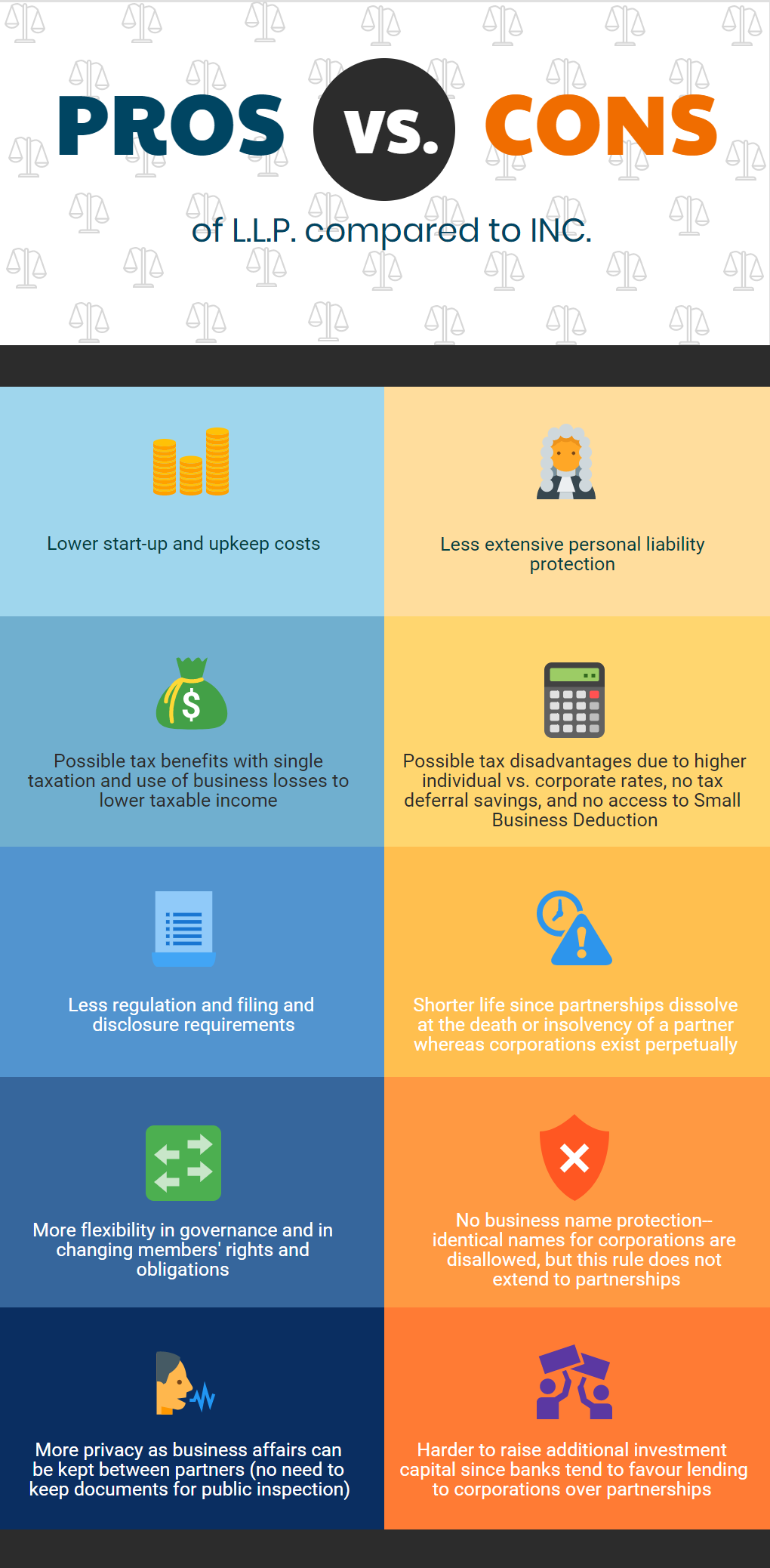LLP VS. INC – WHAT’S THE DIFFERENCE?
Thinking of starting your own small business with a colleague? Choosing the right ownership structure may be one of your earliest decisions, and with it comes important tax and liability considerations. Two common options for small business owners are the limited liability partnership and the corporation. The below info graphic illustrates the main pros and cons of the two business structures succinctly:

Limited Liability Partnership (L.L.P.)
An LLP is formed by 2 or more partners with equal rights and powers in managing the business.
B.C. is the only Canadian province to allow almost any type of business to be carried on through an LLP; in most other provinces, LLPs can only be formed by regulated professional service providers such as lawyers and accountants.
Corporation (INC.)
Unlike the LLP, a corporation can be formed by 1 owner (i.e. shareholder) and is considered a separate legal entity with the same rights and obligations under Canadian law as any natural person.
Note that certain regulated professionals looking to incorporate their practice may be required by their governing body and provincial legislation to set up a “professional corporation” (P.C.) rather than a regular corporation. A PC is different in that all shareholders must be members of the applicable profession, and shareholders are not protected against legal liability for malpractice and negligence. Aside from this, PC shareholders still enjoy many of the same benefits as shareholders of regular corporations.
L.L.P. vs. INC.
So what’s the difference between the LLP and INC? Let’s look at three key concerns of any small business owner: liability protection, taxes, and costs.
Liability Protection – Having limited liability means your personal assets are shielded from business obligations. In the event of a claim against the LLP or INC, the amount you can lose is limited to how much you have invested in the business since your personal assets are protected from legal action.
LLPs limits your liability when it comes to the malpractice or negligence of your business partners. If your partner or someone under his/her direct supervision or control commits a negligent or wrongful act or omission, you are not liable for any of the consequent debts, liabilities, or obligations. However, you may be liable if you knew about it and didn’t take reasonable actions to prevent it. You are also liable for your own actions and that of someone you directly supervise or control. As a result, the LLP is a popular choice in high-risk professional environments where one partner may not be aware of the other’s daily operations.
Note that the extent of liability protection in an LLP differs between jurisdictions (provinces). In partial shield jurisdictions like Alberta and Manitoba, limited liability only applies to malpractice claims. Partners have unlimited liability for other claims like breach of contract and general tort liability. In full shield jurisdictions like B.C. and Ontario, partners have limited liability for all claims, whether malpractice or contractual.
In contrast, corporations are separate legal entities liable for their own debts and obligations, so shareholders have no personal liability at all for commercial activities. This makes corporations more advantageous over LLPs in partial shield jurisdictions, particularly for businesses operating heavily in contract-based environments.
Taxes – Earnings and losses of the LLP are allocated among partners and taxed on partners’ personal tax returns at individual tax rates. Conversely, the corporation is considered a completely separate taxpayer so earnings and losses are reported on its own return and taxed at corporate tax rates. When the corporation’s profits are distributed to shareholders, the income is taxed once again at the shareholder level. Known as “double taxation”, this is often seen as the main drawback of INCs.
On the flip side, corporations have an edge over LLPs in that corporate tax rates are generally lower than individual rates. This is especially true if the corporation meets the definition of a “Canadian-controlled private corporation”, wherein a significantly reduced tax rate is applied to the first $500,000 of business income (the “Small Business Deduction”). If you’re earning more income than you need to live in a year, you can save money by leaving the surplus in the corporation and defer paying taxes on those funds until you withdraw them at a more advantageous time, such as at retirement when your personal tax rates are lower. This cannot be done in an LLP. But with careful tax planning, both an LLP and INC offer income splitting opportunities to further reduce the overall tax liability of your family.
In the case of new businesses expected to incur losses in the first years of operation, the LLP may be more tax-friendly than the corporation. Partners in an LLP may offset the losses against the business’ profits to report a lower taxable income, and therefore pay less tax. This is not permitted for corporations as all losses are reported on the corporation’s separate tax return.
Costs – An LLP is less expensive to set up and run than an INC. While annual reports and registration fees may be required, there are no statutory rules, minimal filing and disclosure requirements, and flexibility in governance and changing of members’ rights and interests. For corporations, initial filing fees are accompanied by ongoing costs of complying with regulatory requirements (more stringent than for any other form of business organization), extensive record-keeping, and preparing and filing annual corporate tax returns. The LLP therefore appeals to many who want limited liability and tax advantages while avoiding the complications and upkeep of incorporating.
Still not sure whether what form of ownership structure is right for you? Contact Insight Online Accountants and we’ll discuss what’s best for your business.




